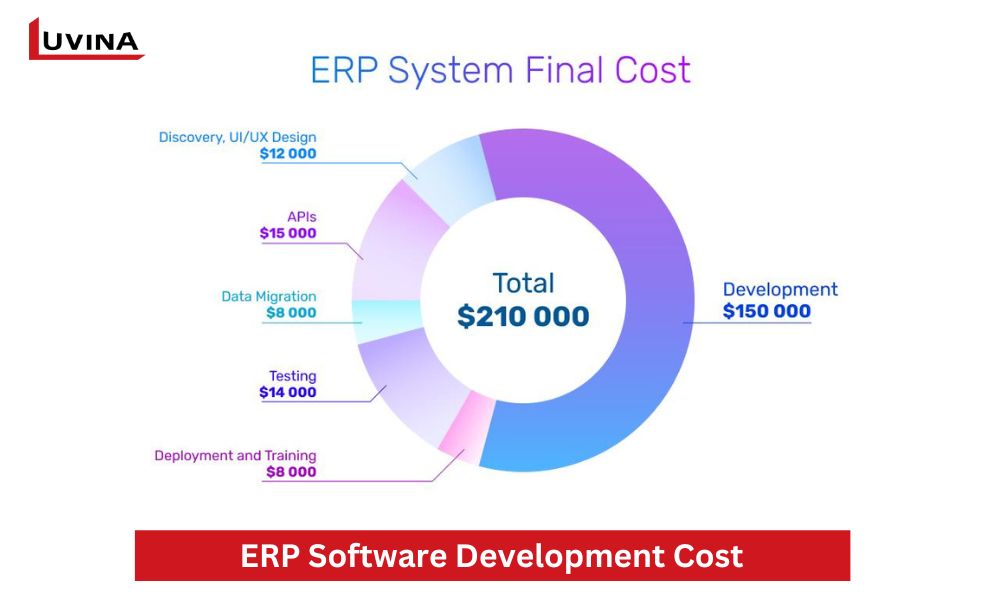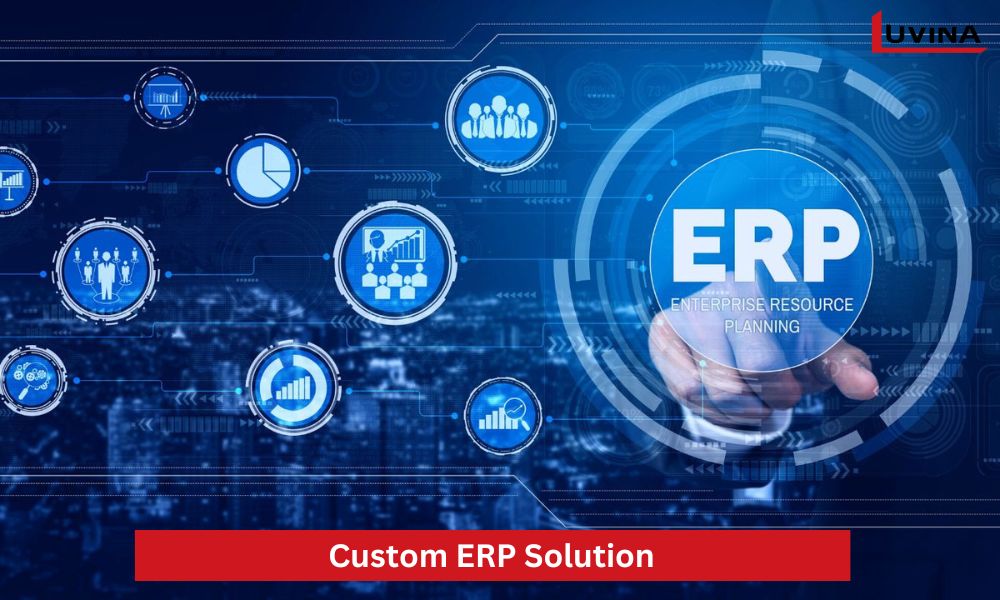ERP software development cost is a concern for many businesses. ERP is a solution that can help improve business operations, providing a competitive edge in the market. However, it’s undeniable that custom solutions like ERP entail significantly higher costs compared to off-the-shelf systems. If you’re considering developing an ERP for your business, let’s explore information about ERP development costs in the article below.
6 Factors affecting ERP software development cost
Developing an ERP system is a complex process. That’s why it’s challenging to determine the specific costs involved. Typically, ERP software development costs are influenced by the following six factors:
- Implementation: Implementing an ERP system is often complex. Businesses not only need an experienced team to install it but may also require server upgrades to ensure smooth operation. All these deployment activities incur costs.
- Training: Employees need guidance on using the new ERP system. ERP providers often offer training services charged on an hourly basis. Therefore, training costs significantly impact the overall cost of ERP development.
- Business process redesign: When upgrading or transitioning to an ERP system, businesses need to redesign several processes for compatibility. ERP automates manual processes to enhance efficiency. These changes require time, effort, and additional costs.

- Maintenance: Like any software, regular maintenance is essential for an ERP system. Budgeting for maintenance should include hardware costs, network fees, and labor costs.
- Upgrades: Continuous upgrades are necessary to prevent the ERP system from becoming outdated. Upgrade costs affect ERP software development costs, potentially requiring adjustments to business processes, hardware, software, and more.
- Support: Businesses need technical support from ERP providers to address issues during system use. Some ERP providers include this in the initial development fee, while others may charge additional fees for ongoing support. Therefore, businesses need to clarify this aspect during the contract negotiation phase.
Beyond these 6 factors affecting ERP development costs, if there is a need for additional features, businesses will incur additional expenses for developing these supplementary functionalities. The more complex and feature-rich the ERP system, the higher the development costs.
Off-the-shelf vs. Custom ERRP Solution: Pros, cons, and cost
Off-the-shelf is a ready-made software solution with basic features to fit the majority of businesses. On the other hand, an ERP system is customized based on each business’s requirements. After receiving requests, development companies deploy features tailored to address the specific issues the business is facing.
So, what are the pros and cons of these two methods, and how do ERP software development costs and off-the-shelf costs differ? Let’s follow the comparison below.
Off-the-shelf solution
Pros:
- – Readily available for immediate use.
- – Lower cost (since the software has already been developed, tested, and sold multiple times).

Cons:
- – Lack of specific functionalities (as it’s developed to meet the basic needs of the majority of customers).
- – Limited updates.
- – Additional fees for new features.
- – Requires examination and adjustments to business processes to align with available features.
- – Potential conflicts between technical solutions, security, and company internal processes.
Cost
The cost of off-the-shelf software depends on included modules, business scale, etc. For example, a solution for 10 users may cost around $49,160 for perpetual licenses and approximately $23,550 for cloud-based systems. As the company scales up, the fees increase. Similarly, a solution for a 100-user company could cost up to $431,000 for perpetual licenses and $268,500 for cloud-based systems.
Custom ERP solution
Pros:
- – Rich features, flexible customization, and the ability to add modules.
- – Addresses specific issues the business is facing.
- – Free future updates.
- – User-friendly, and requires minimal training.
- – Compatible with business security requirements.
Cons:
- – Takes time to develop, usually 6 months to 1 year.
- – Higher costs.

Pricing:
The development cost of ERP depends on the included modules. ERP with more modules generally has higher costs, ranging from $45,000 to $250,000 on average.
While it may incur higher costs compared to off-the-shelf, a customized ERP system is created for and by the business. Therefore, if you are seeking a solution to accurately address the specific issues your business is facing, ERP remains a more suitable choice.
For whom is the custom ERP solution intended?
Bringing significant benefits to business operations, a custom ERP solution is suitable for the following companies:
- Small and medium-sized enterprises (SMEs) that want a system tailored to their specific processes, avoid the bloat of one-size-fits-all packaged software.
- Businesses operating in specialized industries such as make-to-order manufacturing, specialized logistics, complex supply chains, or high-tech services.
- Companies with unique internal processes that have developed their own operational workflows need a flexible ERP system that can integrate seamlessly with their existing methods.
- Fast-growing companies or those planning to scale that want a solution capable of expanding, customizing, and evolving alongside their organization’s long-term growth.
- Businesses seek competitive advantage by using a “tailor-made” ERP system to optimize operations, reduce costs, and respond quickly to market changes.
- Organizations require deep integration with other systems such as CRM platforms, eCommerce solutions, IoT devices, or specialized management software.

Luvina – Your reputable partner in ERP software development
If you are looking for a reliable ERP development company, Luvina will be one of your top choices. With a skilled team, Luvina can help customize an ERP solution according to your business needs and seamlessly integrate the software into your company’s system.
The Luvina team has experience with well-known ERP systems such as GrandIT, Microsoft Dynamic 365 ERP (and DynamicAX), and Workday, SAP. We specialize in developing modules such as accounting, production management, inventory management, sales management, etc.

Throughout the ERP customization collaboration, Luvina commits to providing:
- – The best quality of service (Luvina holds both ISO 27001 and CMMI Level 3 certifications).
- – Continuous communication and support 24/7, regardless of time zones, with staff proficient in Vietnamese, English, and Japanese.
- – A team of over 750 experienced IT experts to easily adjust the IT team’s scale based on customer requirements.
Contact Luvina now to plan ERP software development costs and implement a dedicated ERP system for your business.
Get in touch now
to get a free consultant from us
Conclusion
Determining the exact ERP development cost is not easy. The specific figures depend on the number of users, features, and many other factors. This article has given you a clearer understanding of ERP software development costs.
Choosing between a custom ERP solution and an off-the-shelf one depends on each business, as each solution has its pros and cons. However, make sure you choose a solution that delivers long-term results. In the case of opting for ERP development, outsourcing in Vietnam can be one of the ways to reduce costs that you should consider.
Related Posts:









Read More From Us?
Sign up for our newsletter
Read More From Us?
Sign up for our newsletter